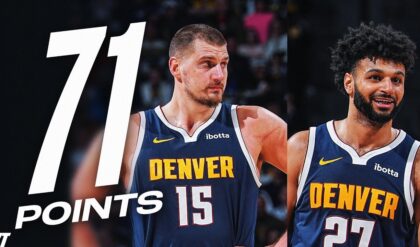
Gleyber Torres’ 2024 tenure with the New York Yankees has been a rollercoaster ride. From early struggles to a late-season resurgence, he has shown flashes of brilliance and moments of frustration. Despite this inconsistency, Torres remains one of the most valuable infield options for the Yankees, offering a unique combination of offensive production, cost efficiency, and potential upside that sets him apart from free-agent and trade alternatives.
As Torres enters free agency, his future in the Bronx hangs in the balance. Here’s why the Yankees should strongly consider re-signing the versatile infielder and why letting him go could be a costly mistake.
2024: Torres’ tale of two seasons
His 2024 campaign was emblematic of his career—a mix of struggles and standout moments. Early in the season, Torres hit a slump, posting a subpar .236/.309/.349 slash line in his first 481 plate appearances. His power numbers were concerning, with career-lows in hard-hit ball rate (35.4%) and barrel rate (6.3%). These struggles saw him lose the leadoff spot in the lineup, further compounding his challenges.
However, a turning point came in mid-August when manager Aaron Boone reintroduced Torres to the leadoff position. The move revitalized his game, as he hit .313/.386/.454 in his final 184 plate appearances, showing improved plate discipline and confidence at the plate. This late-season surge carried into the playoffs, where Torres was instrumental in the Yankees’ run to the World Series. While the Dodgers’ pitching ultimately cooled his bat in the Fall Classic, Gleyber’s contributions were vital in securing the team’s AL pennant. gleyberdavid@Insta
gleyberdavid@Insta
The free-agent dilemma
Now a free agent, Torres is generating interest across the league, with teams like the Angels and Blue Jays reportedly in pursuit. Despite his uneven 2024, Gleyber remains an attractive target due to his offensive potential and age—he’s just shy of 28.
Torres posted a 104 wRC+ in 2024, a slight dip from the 118 wRC+ he averaged over the previous two seasons. While his walk rate and home run power declined, his ability to bounce back late in the season suggests he has more to offer. MLBTradeRumors projects a two-year, $36 million deal for Torres, though he may opt for a one-year contract to rebuild his value and test free agency again in 2025.
Comparing alternatives and Torres’ plus points
The Yankees face a pivotal decision: re-sign Torres or explore other options via free agency or trade. Let’s evaluate the alternatives.
Whit Merrifield (free agent)
Strengths: A contact hitter with speed and versatility.
Weaknesses: At 35, Merrifield’s declining power and age limit his long-term value.
Comparison: While Merrifield brings flexibility, he lacks Torres’ power and potential upside.
Jeimer Candelario (free agent)
Strengths: A reliable bat with switch-hitting capability and solid defense at third base.
Weaknesses: Primarily a third baseman, he doesn’t address the Yankees’ needs at second base.
Comparison: Candelario is a solid option but doesn’t replicate Gleyber’s offensive production or positional fit.
Justin Turner (free agent)
Strengths: Veteran leadership and clutch hitting.
Weaknesses: At 40, Turner’s durability and defensive limitations are concerns.
Comparison: Turner offers short-term value but lacks the youth and athleticism Torres brings.
Nolan Arenado (via trade)
Strengths: Elite defense and consistent offensive output.
Weaknesses: A hefty contract and potential decline with age.
Comparison: While Arenado is a superstar, acquiring him would require significant financial and prospect capital, unlike Torres, who is a more affordable option.
Tim Anderson (via trade)
Strengths: High-contact hitter with speed and positional flexibility.
Weaknesses: Defensive struggles and declining offensive numbers.
Comparison: Anderson’s skill set overlaps with Torres’, but his recent performance suggests he’s a riskier option.
Ha-Seong Kim (via trade)
Strengths: Elite defense, versatility, and balanced offensive profile.
Weaknesses: Limited power and a likely high trade cost.
Comparison: Kim excels defensively but doesn’t match Gleyber’s offensive output, especially in terms of power.
 NYT
NYTWhy Torres is the best option for Yankees
Offensive production:
Torres’ power and plate discipline set him apart from other infielders. Even in a down year, his offensive metrics remain competitive, and his late-season surge indicates he can still be a difference-maker at the plate. His ability to hit in key situations makes him an invaluable asset in high-pressure games.
Age and cost efficiency
At 28, Torres is entering his prime and offers the Yankees a cost-effective solution compared to older, more expensive free agents or trade targets. Spotrac projects a three-year, $22 million deal—a bargain for a player with his track record and potential upside.
Defensive growth
While defense has been a point of criticism, Torres has shown steady improvement at second base. His metrics, while not elite, position him as a reliable option in the middle infield, especially when paired with a strong defensive shortstop.
Flexibility and familiarity
Torres’ ability to adapt within the infield and hit across different spots in the lineup adds a level of versatility that alternatives can’t easily replicate. His familiarity with the Yankees’ system and clubhouse dynamics further strengthens his case as the best infield option.
The risk of letting Gleyber walk
Losing Torres would create a significant void in the Yankees’ lineup and infield. The alternatives—whether through free agency or trade—come with greater risks, higher costs, and fewer long-term benefits.
For example, replacing Gleyber with an older, declining player like Merrifield or Turner would sacrifice youth and longevity. Similarly, pursuing a star like Arenado or Kim would require substantial financial and prospect investment, potentially limiting the Yankees’ ability to address other areas of need.
The case for Torres’ Yankees return
 NYP
NYP
Gleyber Torres represents the best combination of proven performance, cost efficiency, and future potential for the Yankees. His offensive capabilities, defensive growth, and age make him an irreplaceable piece in the current market landscape.
While some fans may remember his inconsistencies, Torres’ late-season resurgence and postseason contributions highlight his value. Retaining him allows the Yankees to maintain a strong infield foundation while pursuing upgrades in other areas without sacrificing prospects or financial flexibility.
In a competitive free-agent market, Gleyber Torres remains the Yankees’ most logical and impactful choice to secure their infield and strengthen their lineup for the future. Letting him go would not only create gaps but also risk missing out on a player poised to reach new heights in his prime.
What do you think? Leave your comment below.





